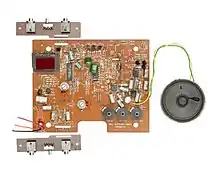 | |
 Action Max with light gun | |
| Manufacturer | Worlds of Wonder |
|---|---|
| Type | Home video game console |
| Generation | Third generation |
| Release date | 1987 |
| Media | VHS tape |
The Action Max is a home video game console using VHS tapes for games. It was manufactured in 1987 by Worlds of Wonder.[1] The system had a very limited release outside the U.S.
Gameplay

Inside the system

The Action Max motherboard
The Action Max system requires the player to also have a VCR,[2] as the console has no way to play the requisite VHS tapes itself. Using light guns, players shoot at the screen. The gaming is strictly point-based and dependent on shot accuracy, and as a result, players can't truly win or lose a game. The system's post-launch appeal was limited by this and by the fact that the only real genre on the system were light gun games that played exactly the same way every time, leading to its quick market decline.[3]
Games
Five VHS cassettes were released for the system:
- .38 Ambush Alley, a police target range;
- Blue Thunder, based on the eponymous 1983 motion picture;
- Hydrosub: 2021, a futuristic underwater voyage;
- The Rescue of Pops Ghostly, a comic haunted-house adventure;
- Sonic Fury, aerial combat, bundled with the system.
Technical specifications
See also
- Control-Vision a prototypical VHS video game console
- View-Master Interactive Vision, another VHS-based console
References
- ↑ Slaven, Andy (2002). Video game Bible, 1985-2002. Victoria, B.C.: Trafford. p. 352. ISBN 1553697316.
- ↑ Gellene, Denise (14 December 1987). "BIG TROUBLE IN TOYLAND : Debt-Ridden Worlds of Wonder, the Maker of Teddy Ruxpin, Is Looking for Way Out of Woods". Los Angeles Times. Retrieved 12 November 2022.
- ↑ Plunkett, Luke (March 28, 2011). "Only In The 80's Would They Put Video Games On A VHS Tape". Kotaku. Retrieved December 26, 2015.
- ↑ Meston, Zach (2007). "Rare Systems". Video Game Collector Magazine. No. 9. p. 10.
- ↑ Rozenkrantz, Jonathan (1 June 2017). "Action Max: Notes on a Deictic Dispositif". residual media depot. Milieux Institute of Concordia University. Retrieved 14 November 2022.
External links
This article is issued from Wikipedia. The text is licensed under Creative Commons - Attribution - Sharealike. Additional terms may apply for the media files.